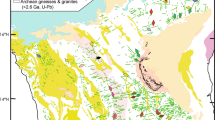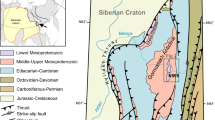Abstract
South Indian granulite terrain had witnessed significant part of Precambrian mafic igneous activity in the form of episodic mafic dyke intrusions of the Palaeoproterozoic period. Strike trends of these dykes are not uniform over the region and the dykes are generally fresh, massive, black dolerites except in the Bhavani shear zone bordering the southern fringes of Nilgiri massif. In Agali-Coimbatore area of our study in the western Bhavani shear zone, the dykes appear to be penecontemporaneous with shearing. Isotopic data place age of Agali-Coimbatore dyke intrusions at about 2.1 Ga. The age of these dykes is significant to constrain an early Palaeoproterozoic age for major shearing event in the Bhavani shear zone. Other dyke emplacement ages are placed at about 1.8 Ga and 1.65 Ga based on the Ar/Ar and K-Ar isotopic results of dykes in Dharmapuri and Tiruvannamalai areas. Older ages comparable to those of the Dharwar craton are not known and in this respect future isotopic dating is vital. Geochemically, these dykes are quartz/hypersthene normative subalkalic tholeiites. An attempt is made here to provide insights into the general petrogenetic history of the Precambrian dykes. Compositional trends are explained by the fractional crystallization of ferromagnesian phases and plagioclase control is conspicuous at the advanced stages of fractionation. Geochemical characteristics suggest that the dykes have tapped Fe-rich non-pyrolite mantle sources with LIL and LREE enrichment as in many continental basalts. The data suggest that role of crustal contamination is limited in petrogenesis; crustal signatures are noticed in the more mafic end members formed in early stage of evolution suggesting that contamination was temperature controlled with most primitive high temperature magmas being most vulnerable to the process. Nd-Sr isotopic data, at present restricted to Agali-Coimbatore dykes, suggest that Palaeoproterozoic magmas tapped subcontinental lithosphere that may have stabilized in the Archaean times at about 3 Ga during the major crustal building activity in the shield region. Further work coupled with isotopic and mineral chemistry will improve our knowledge on the petrological evolution of the dyke magmas and mafic magmatism in general.
Similar content being viewed by others
References
Afnasseyev, G.D., Bayouk, E.I., Belikova, B.P., Volarovich, M.P. and Zalesskii, V.V. (1964) On the Physical properties of some minerals and Rocks of India and Ceylon and their absolute ages: Izvestiia Academiia Nauk USSR. Sci. Geol., v.3, pp.22–24.
Arndt, N.T. and Christensen, U. (1992) The role of lithospheric mantle in continental flood volcanism: Thermal and geochemical constraints. Jour. Geophys. Res., v.97, pp.10967–10981.
Basu, S., Murthy, S.V.S. and Anil Kumar (2005) U, Th-21Ne, a new dating tool: A case study of apatites from Hogenakal Carbonatites. Curr. Sci, v.88, No.3, pp.445–448.
Cartwright, I. and Valley, J.W. (1991) Low-18O Scourie magmas from the Lewisian complex, northwestern Scotland. Geology, v.19, pp.578–581.
Drury, S.A., Harris, N.B.W., Holt, R.W., Reeves-Smith, G.J. and Wightman, R.T. (1984) Precambrian tectonics and crustal evolution in south India. Jour. Geol., v.92, pp.3–20.
Eiler, J.M. (2001) Oxygen isotope variations of basaltic lavas and upper mantle rocks. Rev. Mineral. Geochem., v.43, pp.319–364.
Furnes, H., Hertogen, J., Mitchell, J.G., Austraheim, H. and Sinha-Roy, S. (1983) Trace element geochemistry and age of mafic dykes from the Kerala region, India. Neues. Jahrb. Miner. Abh, v.146, pp.82–100.
Gallagher, K. and Hawkesworth, C.J. (1992) Dehydration melting and generation of continental flood basalt. Nature, v.358, pp.57–59.
Ghosh, J.G., de Wit M.J. and Zartman, R.E. (2004) Age and tectonic evolution of Neoproterozoic ductile shear zones in the Southern Granulite Terrain of India, with implications for Gondwana studies. Tectonics, v.23, pp.1–38.
Goplakrishnan, K. (1996) An overview of southern granulite terrain, India-constraints in reconstruction of Precambrian assembly of Gondwanaland. Gondwana Nine, v.2, Oxford and IBH, New Delhi, pp.1003–1026.
Guru Rajesh, K. and Chetty, T.R.K. (2006) Structure and tectonics of the Achankovil shear zone, southern India. Gondwana Res., v.10, pp.86–98.
Halls, H.C. and Fahrig, W.F. (1987) Mafic Dyke Swarms, Geol. Assoc. Can. Spec. Publ., v.34, pp.503.
Halls, H.C., Kumar, A., Srinivasan, R. and Hamilton, M.A. (2007) Palaeomagnetism and U-Pb geochronology of easterly trending dykes in the Dharwar craton, India: feldspar clouding, radiating dyke swarms and position of India at 2.37 Ga. Precambrian Res., v.155, pp.47–68.
Harris, N.B.W., Santosh, M. and Taylor, P.N. (1994) Crustal evolution in south India: constraints from Nd isotopes. Jour. Geol., v.102, pp.139–150.
Jiang, J., Clayton, N. and Newton, R.C. (1988) Fluids in granulite facies metamorphism: A comparative oxygen isotope study on the south India and Adirondack high-grade terrains. Jour. Geol., v.96, pp.517–533.
Juster, T.P., Grove, T.L. and Perfit, M.R. (1989) Experimental constrains on the generation of Fe-Ti basats, andesites and rhyodacites at Galpagos spreading centre, 85°W and 95°W. Jour. Geophys. Res., v.94, pp.9251–9265.
Langmuir, C.H., Bender, J.F., Bence, A.E. and Hanson, G.N. (1977) Petrogenesis of basalts from the FAMOUS area: Mid Atlantic Ridge. Earth Planet. Sci. Lett., v.36, pp.133–156.
Mahoney, J.J. (1988) Deccan Traps. In: J.D. MacDougall (Ed.), Continental flood basalts. Kluwer, Dordrecht, pp.151–194.
Meissner, B., Deters, P., Srikantappa, C. and Kohler, H. (2002) Geochronological evolution of the Moyar, Bhavani and Palghat shear zones of southern India: implications for Gondwana correlations. Precambrian Res., v.114, pp.149–175.
Menzies, M.A. and Murthy, V.R. (1980) Mantle metasomatism as a precursor to the genesis of alkaline magmas: isotopic evidence. Am. Jour. Sci., v.28CA, pp.622–638.
Murthy, N.G.K. (1987) Mafic dyke swarms of India shield. In: H.C. Halls and W.H. Fahrig (Eds.), Geol. Assoc.Canada. Spec. Paper, v.34, pp.393–400.
O·Hara, M.J. and Mathews, R.E. (1981) Geochemical evolution in an advancing, periodically replenished, periodically tapped, continuously fractionated magma chamber. Jour. Geol. Soc. London, v.138, pp.237–278.
Pandey, B.K, Gupta, J.N, Sarma, K.J. and Sastry, C.A. (1997) Sm-Nd, Pb-Pb and Rb-Sr geochronology and petrogenesis of the mafic dyke swarm of Mahabubnagar, South India: implications for Palaeoproterozoic crustal evolution of the Eastern Dharwar Craton. Precambrian Res., v.84, pp.181–196.
Patchett, P.J., Lehnert, K., Rehkamper, M. and Sieber, G. (1994) Mantle and crustal effects on the geochemistry of Proterozoic dykes and sills in Sweden. Jour Petrol., v.35, pp.1095–1125.
Pearson, D.G., Davies, G.R., Nixon, P.B., Greenwood, P.B and Mattey, D.P. (1991) Oxygen isotope evidence for the origin of pyroxenites in the Beni Bousera peridotite massif, North Morocco: derivation from subducted oceanic lithosphere. Earth Planet. Sci. Lett., v.102, pp.289–301
Pichamuthu, C.S. (1959) The significance of Clouded Felspars in the Basic Dykes of Mysore State, India. Jour. Geol. Soc. India, v.1, pp.68–79.
Radhakrishna, T., Maluski, H., Mitchell, J.G. and Joseph, M. (1999) K-Ar and 40Ar/39Ar isotope geochronology of the dykes from the south Indian granulite terrain. Tectonophysics, v.304, pp.109–129.
Radhakrishna, T., Mathew Joseph, Krishnendu, N.R. and Balasubramonian, G. (2003) Palaeomagnetism of mafic dykes in the Karnataka Craton: possible geodynamic implications. Mem. Geol. Soc. India, no.50, pp.193–224.
Radhakrishna, T., Poornachandra Rao, G. V. S., Mitchell, J. G. and Venkatesh, A.S. (1986) Proterozoic basic dyke activity in Kerala along the western continental margin of India. Jour. Geol. Soc. India, v.27, pp.245–253.
Radhakrishna, T., Mathai, J. and Yoshida, M. (1990) Geology and structure of the high-grade rocks from Punalur — Achankovil sector, south India. Jour. Geol. Soc. India, v.35, pp.263–272.
Radhakrishna, T., Gopakumar, K., Murali, A.V. and Mitchell, J.G. (1991) Geochemistry and petrogenesis of Proterozoic mafic dykes in north Kerala, southwestern Indian shield-primary results. Precambrian Res., v.49, pp.235–244.
Radhakrishna, T. and Joseph, M. (1993) Proterozoic palaeomagnetism of South Indian shield and tectonic constraints. In: B. P. Radhakrishna (Ed.), Continental crust of south India. Mem. Geol. Soc. India, no.25, pp.321–336.
Radhakrishna, T., Dallmeyer, R.D. and Mathew, J. (1994) Palaeomagnetism and 36Ar/40Ar vs 39Ar/40Ar isotope correlation ages of dyke swarms in central Kerala, India: tectonic implications, Earth Planet. Sci. Lett., v.121, pp.213–226.
Radhakrishna, T. and Joseph, M. (1995) Oxygen isotopes and mantle sources of the mafic dykes in south Indian high-grade terrain. In: T.C. Devaraju (Ed.), Dyke swarms of peninsular India. Mem. Geol. Soc. India, no.33, pp.133–147.
Radhakrishna, T. and Joseph, M. (1996) A Proterozoic palaeomagnetism of the mafic dyke swarms in the high-grade region of south India. Precambrian Res., v.76, pp.31–46.
Radhakrishna, T. (1999) Indian shield in the Rodinia and Gondwana reconstructions: palaeomagnetic and geochronological inferences. In: T. Radhakrishna and J.D.A. Piper (Eds.), The Indian Subcontinent and Gondwana: a palaeomagnetic and rock magnetic perspective. Mem. Geol. Soc. India, no.44, pp.59–74.
Radhakrishna, T. and Joseph, M. (1998) Geochemistry and petrogenesis of the Proterozoic dykes in Tamil Nadu, south India: implications for the continental lithosphere. Geol. Rund., v.87, pp.268–282.
Radhakrishna T., Krishnendu, N.R. and Balasubramonian, G. (2007) Mafic dyke magmatism around the Cuddapah basin: age constraints, petrological characteristics and geochemical inference for a possible magma chamber on the southwestern margin of basin. Jour. Geol. Soc. India, v.70, pp.194–206.
Raith, M., Srikantappa, C., Buhl, D. and Kuhler, H. (1999) The Nilgiri enderbites, south India: nature and age constraints on protolith formation, high-grade metamorphism and cooling history. Precambrian Res., v.98, pp.129–150.
Ramakrishnan, M. (1993) Tectonic evolution of the granulite terrains of southern India. In: B.P. Radhakrishna (Ed.), Continental crust of south India. Mem. Geol. Soc. India, v.25, pp.35–44.
Ramakrishnan, M. (2003) Craton-mobile belt relations in southern granulite terrain. In: M. Ramakrishnan (Ed.), Tectonics of southern granulite terrain. Mem. Geol. Soc. India, no.50, pp.1–24.
Shiraishi, K., Ellis, D.J., Hiroi, C.M., Fanning, Y., Motoyoshi, Y. and Nakai, Y. (1994) Cambrian Orogenic belt in east Antarctica and Sri Lanka: implications for Gondwana assembly. Jour. Geol., v.102, pp.47–65.
Sheraton, J.W., Black, L.P., Mcculloch, M.T. and Oliver, R.L. (1990) Age and origin of a compositionally varied mafic dyke swarm in the Bunger Hills, East Antarctica. Chem. Geol., v.85, pp.215–246.
Sinha-Roy, S. (1983) Age of basic magmatism in Kerala. Jour. Geol. Soc. India, v.24, pp.93–95.
Sinha-Roy, S. and Furnes, H. (1981) Petrology and geochemistry of mafic and felsic dykes from passive continental margin of Kerala region, India. Neues. Jahrb. Miner. Abh., v.142, pp.49–70.
Sugavanam, E.B., Venkatarao, V., Simhachalam, J., Nagal, S.C. and Murty, M.V.N. (1978) Structure, tectonics, metamorphism, magmatic activity and metallogeny in parts of northern Tamil Nadu. In: Tectonics and Metallogeny south and east Asia. Geol. Surv. India Misc. Publ., no.34, pp.95–111.
Tarney, J. (1992) Geochemistry and significance of mafic dyke swarms in the Proterozoic. In: K.C. Condie (Ed.), Proterozoic crustal evolution. Elsevier, Amsterdam, pp.151–179.
Unnikrishnan-Warrier, C., Santosh, M. and Yoshida, M. (1995) First report of pan-African Sm-Nd and Rb-Sr mineral isochron ages from regional charnockites southern India. Geol. Mag., v.132, pp.253–260.
Venkatesh, A.S., Poornachandra Rao, G.V.S., Prasadarao, N.T.V. and Bhalla, M.S. (1986) Palaeomagnetic and geochemical studies on dolerite dykes from Tamil Nadu, India. Precambrian Res., v.34, pp.291–310.
Yui, T.F., Rumble, D. and Lo, Ch (1995) Unusually low 18O Ultra-high pressure metamorphic rocks from the Sulu Terrain, eastern China. Geochim Cosmochim. Acta, v.59, pp.2859–2864.
Author information
Authors and Affiliations
Corresponding author
Rights and permissions
About this article
Cite this article
Radhakrishna, T. Precambrian mafic magmatism in south Indian granulite terrain. J Geol Soc India 73, 131–142 (2009). https://doi.org/10.1007/s12594-009-0008-x
Published:
Issue Date:
DOI: https://doi.org/10.1007/s12594-009-0008-x




